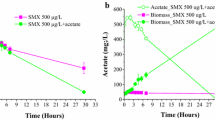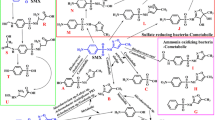Abstract
Antibiotic compounds, like sulfamethoxazole (SMX), have become a concern in the aquatic environment due to the potential development of antibacterial resistances. Due to excretion and disposal, SMX has been frequently detected in wastewaters and surface waters. SMX removal in conventional wastewater treatment plants (WWTPs) ranges from 0% to 90%, and there are opposing results regarding its biodegradability at lab scale. The objective of this research was to determine the ability of pure cultures of individual and mixed consortia of bacteria (Bacillus subtilis, Pseudomonas aeruginosa, Pseudomonas putida, Rhodococcus equi, Rhodococcus erythropolis, Rhodococcus rhodocrous, and Rhodococcus zopfii) known to exist in WWTP activated sludge to remove SMX. Results showed that R. equi alone had the greatest ability to remove SMX leading to 29% removal (with glucose) and the formation of a metabolite. Degradation pathways and metabolite structures have been proposed based on the potential enzymes produced by R. equi. When R. equi was mixed with other microorganisms, a positive synergistic effect was not observed and the maximum SMX removal achieved was 5%. This indicates that pure culture results cannot be extrapolated to mixed culture conditions, and the methodology developed here to study the biodegradability of compounds under controlled mixed culture conditions offers an alternative to conventional studies using pure bacterial cultures or inocula from activated sludge sources consisting of unknown and variable microbial populations.


Similar content being viewed by others
References
Al-Ahmad A, Daschner FD, Kümmerer K (1999) Biodegradability of cefotiam, ciprofloxacin, meropenem, penicillin G, and sulfamethoxazole and inhibition of waste water bacteria. Arch Environ Contam Toxicol 37(2):158–163
Alexy R, Kumpel T, Kummerer K (2004) Assessment of degradation of 18 antibiotics in the Closed Bottle Test. Chemosphere 57(6):505–512
Andersson DI (2003) Persistence of antibiotic resistant bacteria. Curr Opin Microbiol 6(5):452–456
Batt AL, Kim S, Aga DS (2007) Comparison of the occurrence of antibiotics in four full-scale wastewater treatment plants with varying designs and operations. Chemosphere 68(3):428–435
Benedict RG, Carlson DA (1971) Aerobic heterotrophic bacteria in activated sludge. Water Res 5(11):1023–1030
Benotti MJ, Trenholm RA, Vanderford BJ, Holady JC, Stanford BD, Snyder SA (2009) Pharmaceuticals and endocrine disrupting compounds in U.S. drinking water. Environ Sci Technol 43(3):597–603. doi:https://doi.org/10.1021/es801845a
BRENDA The Comprehensive Enzyme Information System http://www.brenda-enzymes.org/index.php4. Accessed 27 Feb 2011
Carballa M, Omil F, Lema JM, Llompart M, Garcia-Jares C, Rodriguez I, Gomez M, Ternes T (2004) Behavior of pharmaceuticals, cosmetics and hormones in a sewage treatment plant. Water Res 38(12):2918–2926
Cavallucci S (2007) Top 200: what's topping the charts in prescription drugs this year? Pharmacy Practice, Canadian Healthcare Network. http://www.imshealthcanada.com/vgn/images/portal/cit_40000873/13/31/8286270612-TOP200-07-final.pdf. Accessed 26 Feb 2008
Costanzo SD, Murby J, Bates J (2005) Ecosystem response to antibiotics entering the aquatic environment. Mar Pollut Bull 51(1–4):218–223
Daughton CG (ed) (2003) Chemicals from pharmaceuticals and personal care products, vol 1. Water: sciences and issues. MacMillan Reference, New York
Daughton CG, Ternes TA (1999) Pharmaceuticals and personal care products in the environment: agents of subtle change? Environ Health Perspect Suppl 107(S6):907–938
Drillia P, Dokianakis SN, Fountoulakis MS, Kornaros M, Stamatelatou K, Lyberatos G (2005) On the occasional biodegradation of pharmaceuticals in the activated sludge process: the example of the antibiotic sulfamethoxazole. J Hazard Mater 122(3):259–265
Gartiser S, Urich E, Alexy R, Kümmerer K (2007) Ultimate biodegradation and elimination of antibiotics in inherent tests. Chemosphere 67(3):604–613
Göbel A, McArdell CS, Joss A, Siegrist H, Giger W (2007) Fate of sulfonamides, macrolides, and trimethoprim in different wastewater treatment technologies. Sci Total Environ 372(2–3):361–371
Goni-Urriza M, Capdepuy M, Arpin C, Raymond N, Caumette P, Quentin C (2000) Impact of an urban effluent on antibiotic resistance of riverine Enterobacteriaceae and Aeromonas spp. Appl Environ Microbiol 66(1):125–132. doi:https://doi.org/10.1128/aem.66.1.125-132.2000
Hirsch R, Ternes T, Haberer K, Kratz K-L (1999) Occurrence of antibiotics in the aquatic environment. Sci Total Environ 225(1–2):109–118
Janke D, Fritsche W (1985) Nature and significance of microbial cometabolism of xenobiotics. J Basic Microbiol 25(9):603–619
Jones O, Voulvoulis N, Lester JN (2005) Human pharmaceuticals in wastewater treatment processes. Crit Rev Environ Sci Tech 35(4):401–427
Jorgensen SE, Halling-Sorensen B (2000) Drugs in the environment. Chemosphere 40(7):691–699
Joss A, Keller E, Alder AC, Göbel A, McArdell CS, Ternes T, Siegrist H (2005) Removal of pharmaceuticals and fragrances in biological wastewater treatment. Water Res 39(14):3139–3152
Joss A, Zabczynski S, Gobel A, Hoffmann B, Loffler D, McArdell CS, Ternes TA, Thomsen A, Siegrist H (2006) Biological degradation of pharmaceuticals in municipal wastewater treatment: proposing a classification scheme. Water Res 40(8):1686–1696
Kolpin DW, Furlong ET, Meyer MT, Thurman EM, Zaugg SD, Barber LB, Buxton HT (2002) Pharmaceuticals, hormones, and other organic wastewater contaminants in U.S. streams, 1999–2000: a national reconnaissance. Environ Sci Technol 36(6):1202–1211
Kümmerer K (2009a) Antibiotics in the aquatic environment—a review—part I. Chemosphere 75(4):417–434
Kümmerer K (2009b) Antibiotics in the aquatic environment—a review—part II. Chemosphere 75(4):435–441
Kümmerer K (2009c) The presence of pharmaceuticals in the environment due to human use—present knowledge and future challenges. J Environ Manage 90(8):2354–2366
Larkin MJ, Kulakov LA, Allen CCR (2005) Biodegradation and Rhodococcus—masters of catabolic versatility. Curr Opin Biotechnol 16(3):282–290. doi:https://doi.org/10.1016/j.copbio.2005.04.007
Martínková L, Kren V, Cvak L, Ovesná M, Prepechalová I (2000) Hydrolysis of lysergamide to lysergic acid by Rhodococcus equi A4. J Biotechnol 84(1):63–66. doi:https://doi.org/10.1016/s0168-1656(00)00332-1
Martínková L, Uhnáková B, Pátek M, Nesvera J, Kren V (2009) Biodegradation potential of the genus Rhodococcus. Environ Int 35(1):162–177. doi:https://doi.org/10.1016/j.envint.2008.07.018
Miège C, Choubert JM, Ribeiro L, Eusèbe M, Coquery M (2009) Fate of pharmaceuticals and personal care products in wastewater treatment plants—conception of a database and first results. Environ Pollut 157(5):1721–1726
Peng X, Wang Z, Kuang W, Tan J, Li K (2006) A preliminary study on the occurrence and behavior of sulfonamides, ofloxacin and chloramphenicol antimicrobials in wastewaters of two sewage treatment plants in Guangzhou, China. Sci Total Environ 371(1–3):314–322
Perez S, Eichhorn P, Aga DS (2005) Evaluating the biodegradability of sulfamethazine, sulfamethoxazole, sulfathiazole, and trimethoprim at different stages of sewage treatment. Environ Toxicol Chem 24(6):1361–1367
Rani A, Porwal S, Sharma R, Kapley A, Purohit HJ, Kalia VC (2008) Assessment of microbial diversity in effluent treatment plants by culture dependent and culture independent approaches. Bioresour Technol 99(15):7098–7107
Reinthaler FF, Posch J, Feierl G, Wust G, Haas D, Ruckenbauer G, Mascher F, Marth E (2003) Antibiotic resistance of E. coli in sewage and sludge. Water Res 37(8):1685–1690
Seviour R, Kragelund C, Kong Y, Eales K, Nielsen J, Nielsen P (2008) Ecophysiology of the Actinobacteria in activated sludge systems. Antonie Leeuwenhoek 94(1):21–33
Ternes T, Janex-Habibi M-L, Knacker T, Kreuzinger N, Siegrist H (2006) Assessment of technologies for the removal of pharmaceuticals and personal care products in sewage and drinking water facilities to improve the indirect potable water reuse (POSEIDON Final Report-EU Research Programme) http://poseidon.bafg.de/servlet/is/2888/. Accessed 1 Feb 2008
Volkmann H, Schwartz T, Bischoff P, Kirchen S, Obst U (2004) Detection of clinically relevant antibiotic-resistance genes in municipal wastewater using real-time PCR (TaqMan). J Microbiol Meth 56(2):277–286
Xu W, Zhang G, Li X, Zou S, Li P, Hu Z, Li J (2007) Occurrence and elimination of antibiotics at four sewage treatment plants in the Pearl River Delta (PRD), South China. Water Res 41(19):4526–4534
Yargeau V, Lopata A, Metcalfe C (2007) Pharmaceuticals in the Yamaska River, Quebec, Canada. Water Qual Res J Can 42(4):231–239
Acknowledgments
This work was funded by the McGill Engineering Doctoral Award (MEDA), The J.W. McConnell Foundation, the Natural Sciences and Engineering Research Council of Canada (NSERC), and Health Canada.
Author information
Authors and Affiliations
Corresponding author
Electronic supplementary material
Below is the link to the electronic supplementary material.
Table 2
Effect of individual bacteria pre-inoculant dilution on mixed bacteria results: maximum growth (optical density measured at 540 nm) and SMX percent removal. Group 1: P. aeruginosa, P. putida, R. equi, R. erythropolis, and R. rhodocrous. Group 2: B. subtilis, P. putida, R. equi, R. erythropolis, R. rhodocrous, and R. zopfii (DOC 34.5 kb)
Figure 3
Structures of a sulfamethoxazole (SMX) and two proposed metabolites of degradation based on the enzyme production of R. equi and P. aeruginosa; b an acetylated by-product and c its alcohol derivative (DOC 31.5 kb)
Rights and permissions
About this article
Cite this article
Larcher, S., Yargeau, V. Biodegradation of sulfamethoxazole by individual and mixed bacteria. Appl Microbiol Biotechnol 91, 211–218 (2011). https://doi.org/10.1007/s00253-011-3257-8
Received:
Revised:
Accepted:
Published:
Issue Date:
DOI: https://doi.org/10.1007/s00253-011-3257-8




